How to make stove heating in the apartment. Stove heating of a private house: varieties, advantages and disadvantages
The history of the Russian stove is rooted in the deep past. But, despite its significant age, the Russian stove has not only survived to this day, practically without changing its design, but also in recent times gained great popularity.
You can meet her in the rural houses of the Russian hinterland, and in modern cottages. Lovers of antiquity are not averse to having a cozy stove in their country house or country house.
What explains the centuries-old popularity of the Russian stove? The fact is that the stove from time immemorial played the role of a hearth and was considered the embodiment of comfort. To some extent, she is a symbol of Russia and the personification of the Russian spirit.
In peasant huts, the stove was not only the main element of the heating system, but was also used for cooking, and a warm stove bench was considered the most comfortable sleeping place.
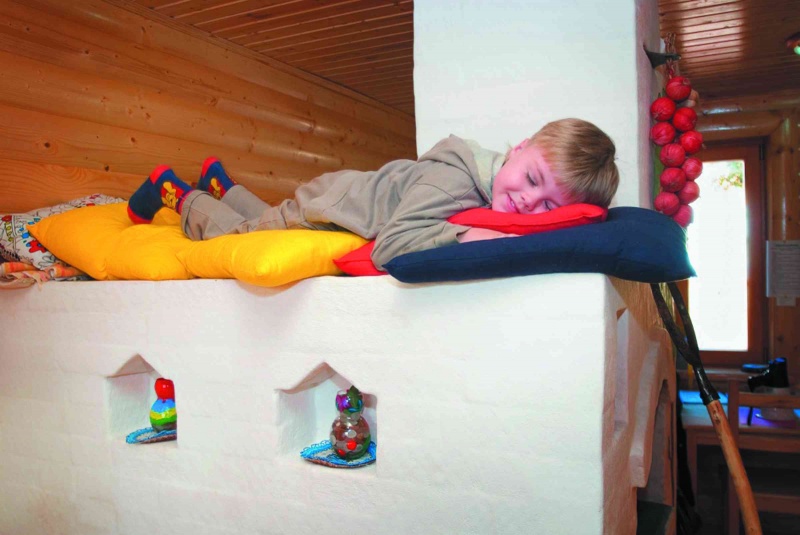
The current stoves, of course, have changed somewhat, they have acquired a more modern look, thanks to new finishing materials they are rarely used for cooking, but they still act as the central element of the dwelling and the main source of heat.
Stove heating is the simplest and most ancient view heating. It is actively used to provide heat in small houses with a height of no more than two floors. This type of heating is often the main one, which is important for areas where the central gas pipeline is not provided. Or it acts as an auxiliary when a heating system with a gas boiler is organized in the house.
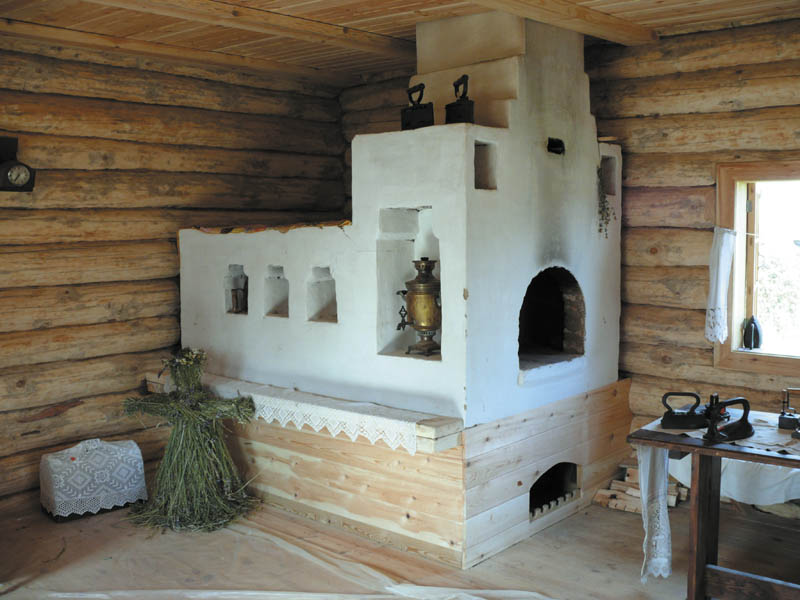
Varieties of furnace heating of a private house
The number of rooms that will be heated depends on the type of construction of the stove installed in the house. The stove can heat both one room and several rooms at the same time.
There are two types of modern furnace heating:
- Heating with a conventional stove. It makes no sense to supply a small country house with a complex heating system. The design of small dimensions perfectly performs the function of heating the room using a minimum amount of fuel.
- Furnace heating with a water circuit. The organization of such a heating system is relevant in large buildings with a height of more than two floors.
In a large house, the stove can be installed on the ground floor in a spacious living room and act as an additional source of heat, and the water circuit will provide heating for all other rooms of the house.
The device of a simple Russian stove
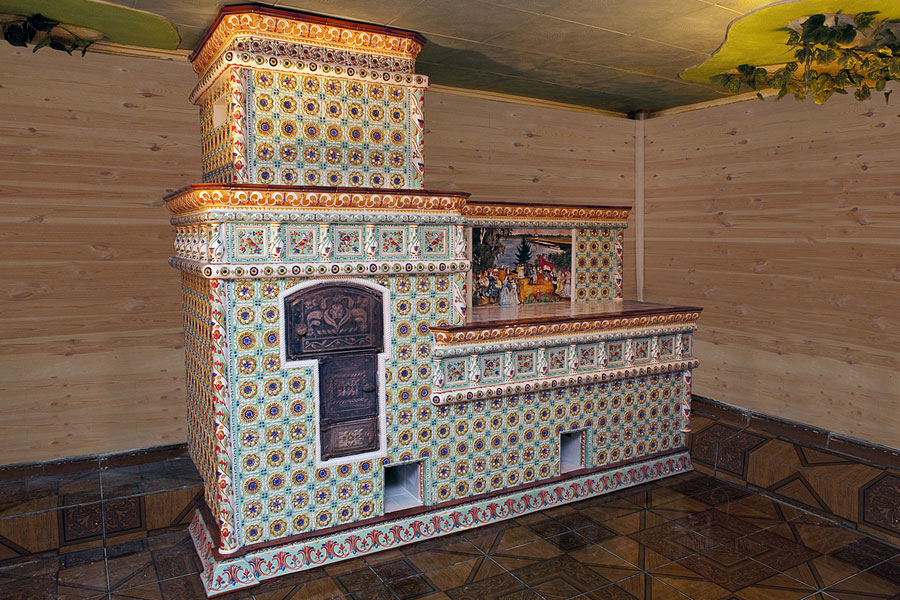
The ideal location of the stove in the house has always been its placement in the center of housing. At the same time, the front part of the stove went into the kitchen and was used by the hostess for cooking. The back wall of the hearth heated the rest of the room.
The stove was necessarily supplied with a multifunctional warm stove bench, on which dishes reached and warmed up, herbs and linen dried, cats warmed up and people slept.
When constructing a structure, it is important to correctly calculate its size. It is usually assumed that 1 m² of the oven should be equipped per 35 m² of the room. Knowing total area at home, count minimum dimensions hearth will not be difficult.
Regardless of the type of construction, any Russian stove has a firebox, an ash collector, boilers and a chimney. For its construction, in most cases, refractory red brick and a clay mortar with sand content are used.
Modern stoves can be fired different types fuel. Commonly used coal, anthracite and timber. Sod peat, pressed sawdust and other woodworking waste, tree bark and waste paper briquettes are also used.
Advantages of furnace heating
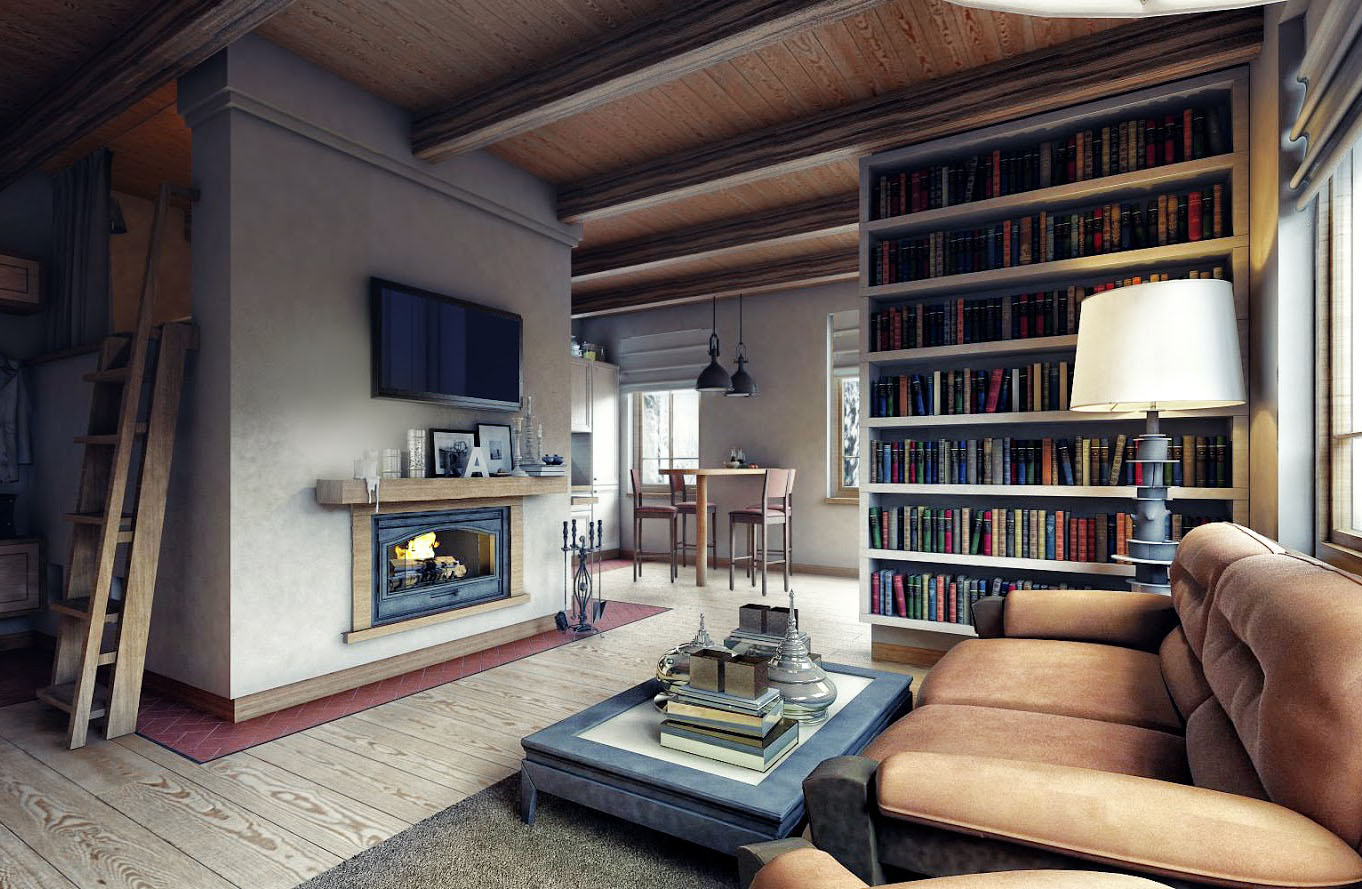
Heating a house with a Russian stove has a lot of advantages:
- the construction of the furnace will not require large financial investments: inexpensive materials are used to create it, you will have to pay for their purchase and the work of the master;
- in addition to the heating device, the owners receive an exclusive decor element, which can also be equipped with a fireplace and equipped with a stove bench for even greater comfort;
- the stove provides complete autonomy of the heating system, you do not need to worry about the availability and possibility of connecting to central communications;
- this type of heating has a relatively high efficiency. A properly built structure has a capacity of about 60%, that is, about the same as a liquid fuel boiler;
- rather cheap raw materials are used for the furnace, which is not a shortage in our country;
- commissioning of the constructed structure does not require any preliminary preparation and complex adjustment;
- stove heating involves the possibility of creating a water circuit;
- and finally: only the stove can create an atmosphere of special comfort and warmth in the house, and the food cooked in it has an incomparable taste!
Disadvantages of furnace heating
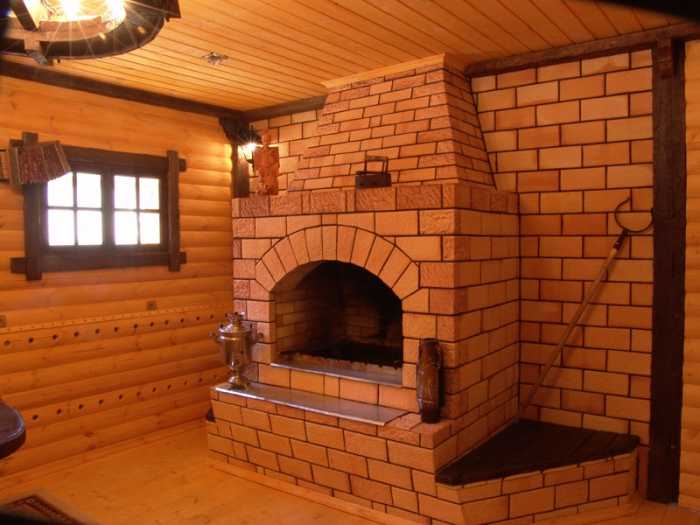
Like other heating systems, heating a building with a stove has a number of disadvantages. First of all, it is necessary to solve the problem of fuel storage. To do this, you need to provide a special place.
There are other disadvantages:
- the oven takes up quite a lot of usable space;
- you need to regularly worry about the procurement of fuel for the cold season;
- the stove warms up for a long time: from the moment of ignition, enough time will pass until the structure begins to fully give off heat;
- operation requires constant monitoring, fuel must be added as it burns out;
- the room warms up unevenly: near the stove, the temperature is always higher than in more remote places;
- mandatory construction of a chimney and its careful isolation from flammable objects is required to reduce the fire hazard;
- if the operating rules are violated, the room may be filled with carbon monoxide.
But it is worth noting that when correct installation and observance of the elementary rules for the operation of the furnace, many shortcomings disappear on their own.
Entrust the masonry to an experienced master, monitor the condition of the indigenous and chimneys, do not place furniture and flammable substances near the oven, and your oven will serve you faithfully for a long time.
In modern times, unusual situations sometimes occur when ancient technologies compete with innovative ones. This statement also applies to the heating sector - today stove heating of a private house can compete in efficiency with the latest heating systems. In addition, this is one of the simple and economical ways to heat your own home in the cold.
We note right away that the installation of stove heating in a private house is possible only if the house is design features will allow you to use it effectively. Sometimes it happens that stove heating is the only way that is possible to heat your home.
Stove heating of a private house
If there is no gas main near your home, then stove heating is right for you. Chop or buy firewood, light the stove and enjoy the comfort and warmth, what could be better?
What to look for before choosing stove heating
We note the advantages and disadvantages that characterize the stove heating of a private house. Perhaps it is thanks to this list that you will be able to understand whether this system is suitable for you. So, among the advantages of stove heating, it is worth highlighting a few:
- The stove is laid out for a relatively short time and the organization of such heating will not require huge investments from you.
- The stove can easily be combined with a fireplace, so you get not only heating equipment, but also a beautiful element of the interior.
- Stove heating country house will provide you with a pleasant atmosphere if you use wood fuel.
- And if you heat with firewood, then it will be affordable and environmentally friendly.
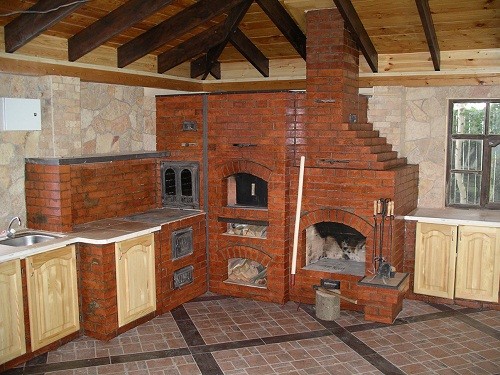
Now a little about the shortcomings of the system:
- A lot of space is required for the stove: after all, the larger the stove itself, the more heat it will give, and the longer it will last.
- Preheating the stove is a rather long process, and it will take a long time until the stove starts to give off enough heat.
- A chimney is necessary, but at the same time, it is also a place of great heat loss.
- And if you compare stove heating with other systems, then for giving the efficiency will be very low.
An important point to consider: heating a private house will require approximately 550 kcal. This means that in order to effectively heat a room of 35 square meters, you need 1 square meter of the stove. In addition, when arranging a stove for heating houses, you also need to take into account both heat loss and the total area of \u200b\u200byour home.
Features of the design of the stove
Before you start equipping the heating with a stove, you should develop a project. During the drafting of the project, the exact location for the stove is determined, as close as possible to the center. The back wall will heat the house, and the front part of the stove should be turned into the kitchen. After all, with the help of a stove you can not only heat the house, but also cook food. Typically, stove heating at home involves laying a brick stove on special kind clay solution.

The furnace structure includes the following elements:
- firebox;
- boilers;
- ash collector;
- flue pipe.
The source of heat is the flame of the lower part and the smoke entering the chimney through the boilers. Note that in conventional ovens, the main solid fuel- it's wood. And if you have a very large room, then you can simply light the stove with firewood, and heat the house with coal, since it is coal that gives powerful heat.
Furnace with heat carrier
Stove heating wooden house in this case, it assumes the presence of such a coolant as water. In essence, this is a combination of stove heating and water heating. Only the efficiency is increased, and the heat is distributed evenly throughout the room, which allows the use of fuel even more rationally.

The water circuit scheme has all the advantages that both furnace and water heating. water system built into the stove - and therefore the heat in the room is distributed evenly. In addition, an important point is that thanks to the built-in water heating, several rooms can be heated at the same time.
Thus, in this case, stove heating of low-rise buildings is a kind of solid fuel boiler. The only difference is that along with the heating of the heat carrier in the stove, the smoke channels and walls will heat up. Heat will be transferred not only from the stove to the radiators, but also from the heated surface - directly into the room. Note that stove heating projects are made only for those houses that have no more than two floors.
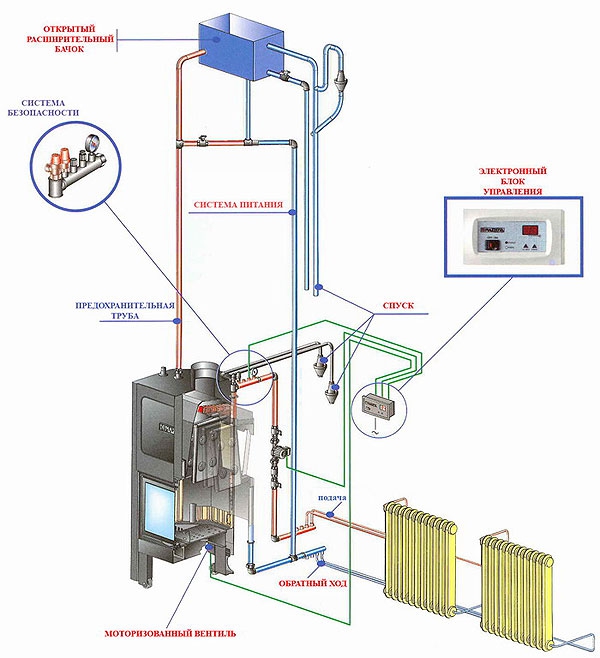
Furnace heating system with water circuit
So, stove heating of a two-story house, which is also equipped with water heating, can be organized in two versions.
- What to look for before choosing stove heating
- Features of the design of the stove
- Furnace with heat carrier
- Furnace heating system with water circuit
In modern times, unusual situations sometimes occur when ancient technologies compete with innovative ones. This statement also applies to the heating sector - today stove heating of a private house can compete in efficiency with the latest heating systems. In addition, this is one of the simple and economical ways to heat your own home in the cold.
We note right away that the installation of stove heating in a private house is possible only if the house, according to its design features, allows it to be used effectively. Sometimes it happens that stove heating is the only way that is possible to heat your home.
Stove heating of a private house
If there is no gas main near your home, then stove heating is right for you. Chop or buy firewood, light the stove and enjoy the comfort and warmth, what could be better?
What to look for before choosing stove heating
We note the advantages and disadvantages that characterize the stove heating of a private house. Perhaps it is thanks to this list that you will be able to understand whether this system is suitable for you. So, among the advantages of stove heating, it is worth highlighting a few:
- The stove is laid out for a relatively short time and the organization of such heating will not require huge investments from you.
- The stove can easily be combined with a fireplace, so you get not only heating equipment, but also a beautiful element of the interior.
- Stove heating of a country house will provide you with a pleasant atmosphere if you use wood fuel.
- And if you heat with firewood, then it will be affordable and environmentally friendly.
Very often stoves are also used for cooking.
Now a little about the shortcomings of the system:
- A lot of space is required for the stove: after all, the larger the stove itself, the more heat it will give, and the longer it will last.
- Preheating the stove is a rather long process, and it will take a long time until the stove starts to give off enough heat.
- A chimney is necessary, but at the same time, it is also a place of great heat loss.
- And if you compare stove heating with other systems, then for giving the efficiency will be very low.
An important point to consider: heating a private house will require approximately 550 kcal. This means that in order to effectively heat a room of 35 square meters, you need 1 square meter of the stove. In addition, when arranging a stove for heating houses, you also need to take into account both heat loss and the total area of \u200b\u200byour home.
Features of the design of the stove
Before you start equipping the heating with a stove, you should develop a project. During the drafting of the project, the exact location for the stove is determined, as close as possible to the center. The back wall will heat the house, and the front part of the stove should be turned into the kitchen. After all, with the help of a stove you can not only heat the house, but also cook food. Typically, stove heating at home involves laying a brick stove on a special type of mortar with clay.
The design of the heating stove
The furnace structure includes the following elements:
- firebox;
- boilers;
- ash collector;
- flue pipe.
The source of heat is the flame of the lower part and the smoke entering the chimney through the boilers. Note that in conventional stoves, the main solid fuel is firewood. And if you have a very large room, then you can simply light the stove with firewood, and heat the house with coal, since it is coal that gives powerful heat.
Furnace with heat carrier
Stove heating of a wooden house in this case assumes the presence of such a coolant as water. In essence, this is a combination of stove heating and water heating. Only the efficiency is increased, and the heat is distributed evenly throughout the room, which allows the use of fuel even more rationally.
Heating system with stove and gas boiler
The water circuit scheme has all the advantages that both stove and water heating provide. The water system is built into the stove - and therefore the heat in the room is distributed evenly. In addition, an important point is that thanks to the built-in water heating, several rooms can be heated at the same time.
Thus, in this case, stove heating of low-rise buildings is a kind of solid fuel boiler. The only difference is that along with the heating of the heat carrier in the stove, the smoke channels and walls will heat up. Heat will be transferred not only from the stove to the radiators, but also from the heated surface - directly into the room. Note that stove heating projects are made only for those houses that have no more than two floors.
Upgraded heating system with stove
Furnace heating system with water circuit
So, stove heating of a two-story house, which is also equipped with water heating, can be organized in two versions:
- Laying the stove from scratch based on the dimensions of the selected heat exchanger.
- Mounting the register in the oven, already existing.
If you choose the second method, then a register is made that fits the dimensions of the firebox. But with any decision, one rule must be observed - the internal size of the water jacket should not be less than 4 centimeters, since the heat carrier can boil during natural circulation. If the pump will work in the system, then the thickness of the water jacket can be made smaller.
For water furnace heating, a heat exchanger with a wall thickness of 3 to 5 mm is used. If the values are smaller, then the register may burn out, so this may cause it to be replaced frequently.
In addition, the type of fuel also affects the wall thickness - for example, with wood it can be less, and if you have stove heating in the country with coal, then more.
We also note that in order for the heating of the room to be efficient and the thermal expansion to be compensated, a gap should be left between the heat exchanger and the wall of the firebox by about 0.5-1.5 cm.
Thus, if you do not have a gas pipeline nearby, stove heating will save you. It is economical and effective method warm your home in cold times.
LLC TeploStroyMontazh.



